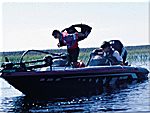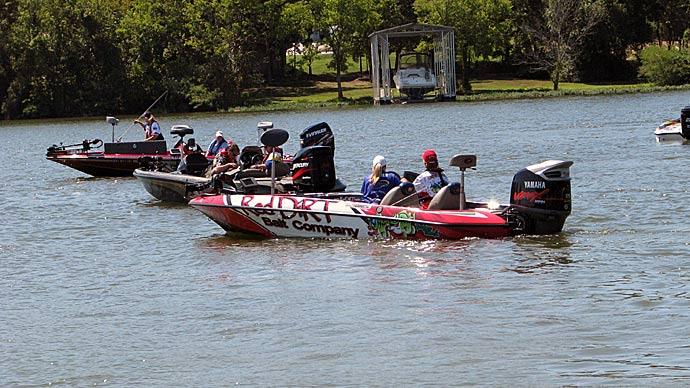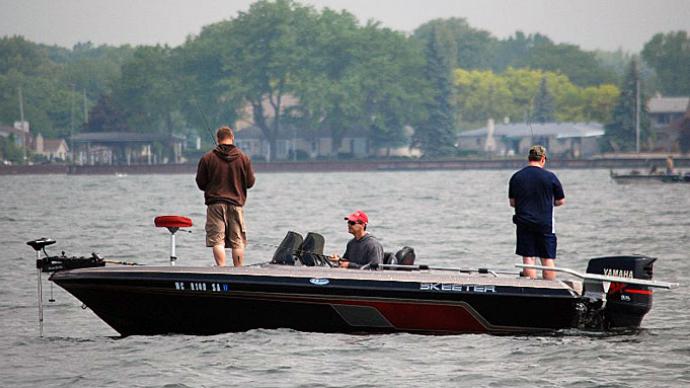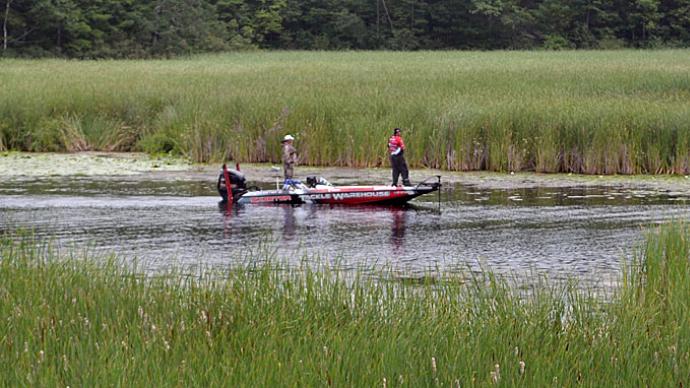
Recreational fishermen die yearly because they fail to follow a few basic boating safety rules. According to statistics compiled by the Pennsylvania Fish and Boat Commission, 12 of 18 drowning victims died due to hypothermia in 1997, and the vast majority of all drowning victims throughout the United States weren't wearing a life preserver.
Statistically speaking, bass fishing is an innocuous sport. A minor tendonitis of the elbow, hook in the hand, or maybe an acute case of sunburn is about all angler's face. Fishermen are at far more risk driving to and from the boat ramp than they are while on the water.
But as with life in general, fishing does have its hazards. Every year, a headline story in a small-town newspaper or a short blurb in a large metropolitan paper recalls another drowning victim, often an angler venturing out for an early spring fishing trip. That's precisely what happened to a Pennsylvania angler last February. Galen Walters, a seasoned smallmouth angler, was fishing alone on the Susquehanna River near Harrisburg when he disappeared. His jet boat was found, still anchored in the river, with a pile of tools lying across the back deck next to the motor's cowling. He had engine trouble. The river was thick with ice that day, and while no one knows for sure, one theory suggests that a chunk of ice bumped Walters' boat, and he went overboard, swept away by the river's powerful current. He wasn't wearing a life vest, the most elementary boating safety rule. What was Walters thinking? Like most drowning victims, he probably thought, "It won't happen to me."

Hypothermia was probably responsible for cooling the body's core temperature. In icy water, essential human functions slow quickly and dramatically. Trying to swim or tread water causes the body to lose heat even faster, so a life preserver is essential.
Randy Howell knows how dangerous bass fishing can be. He was one lightning strike away from becoming yet another statistic. The Trussville, Ala. pro was practicing for a major tournament on the Louisiana Delta when he noticed storm clouds brewing directly between him and safety. And they were moving towards him, fast.
"I started running all around looking for some shelter, but there was nothing around at all. The entire area is one big flat marsh with no houses or other form of safety for miles. I was a long way from the dock, so I did the only thing that I could think of," he says.
Security, at least in Howell's mind, was found in a tall patch of aquatic vegetation that stood about 12 feet high. He ran his boat up into the canes, squatted down on the floor, and prayed for safety as the intense storm dumped rain into his boat faster than his bilge pump could remove it. Water pooled on the floor as lightning cracked all around. It was a violent storm.
"I thought about getting into my rod locker, but there was so much equipment in there I didn't try to empty it. I didn't think I had time. Luckily, the storm passed, and I was okay," he says.
Howell was lucky. Hundreds of other outdoor enthusiasts aren't. An angler was struck by lightning on the Potomac River several years ago as he was trying to run for safety, much like Howell was on that day. Although there are no hard statistics available for lightning victims throughout the country, Walt Zaleski, a meteorologist with the National Weather Service office in Tampa, said in Florida between 1959 and 1996, 374 people were killed by lightning; another 1,337 were struck but survived. Lightning nationwide kills an estimated 73 people each year.
So what do you do if a nasty electrical storm pins you far from the security of an enclosed building or a parked car? Sure, everyone knows the basics of lightning safety, but what angler hasn't been caught with his guard down as a thunderstorm cuts him off from the quickest route to a safe hiding place? Getting caught in a violent storm is one of the most frightening things a boater can face.

"By not paying attention to either a weather radio or the weather itself, you've put yourself in a perilous situation," Zaleski says. "In (Howell's) situation, there isn't much he could have done except to get back to safety before the storm came through. Climbing into the rod storage might have helped since the boat is made of fiberglass, which doesn't conduct electricity, but lightning does all kinds of strange things. You never know."
The obvious solution is to get to shore, even if the entire shoreline is wooded. The worst option is to be the highest thing around - a boat filled with metal and graphite sitting on wide-open water. We all know that standing under a tree is one of the most dangerous things we can do during a lightning storm. Still, the key adds Zaleski, is to find the lowest trees in the forest and stand next to them, or even better, on the ground lower than those lowest trees, even if it means the open lake bank. Howell made a mistake by pulling into those tall canes. The combination of the metal on the boat and the height of the canes could have been catastrophic.
"Lightning is usually going to go for the tallest thing around, although nothing is fool-proof when it comes to avoiding a strike," Zaleski says. "There have been cases where a lightning bolt reached out horizontally 10 miles before it struck something."
This brings up another critical point. He adds that the most dangerous part of an electrical storm is the outer edge, not the middle of the storm itself. So if you wait until those darkest clouds are right on top of you, you may have waited too long. Zaleski says to think of a storm as a sombrero, a big hat with a wide brim. The crown represents the middle of the storm, while the brim represents the outer edge, the area that has the most potential for producing a lightning strike.

Lightning and drowning are not the only dangers anglers encounter. Although most reservoirs are small enough to defeat extremely rough water brought on by high winds, a few tournaments are held on massive bodies of water that whip into a frenzy. That's what Muscle Shoals, Ala., pro Tim Horton faced on the St. Lawrence River during a tournament in 1999. He and his partner were fishing in Chaumont Bay, typically a 30-minute run from the boat ramp at Clayton, N.Y. But as the day wore on, the wind picked up, and before Horton could decide to head back early, he was forced to run through 8- to 9-foot waves pushed by 35- to 40-mph winds across Lake Erie. The boat ride back to the ramp took nearly three hours, but Horton kept a cool head despite the dangerous situation.
"I think that's the most important thing to remember: keep cool and don't panic. We just took our time and didn't try to do anything stupid," he says. "The wind blew the tops of the waves off and onto us. My partner and I were drenched and cold, but we made it back in one piece."
So how do you handle a bass boat in big, rough water? Horton did the right thing by zigzagging across the waves, a lesson learned through years of running a boat across big southern reservoirs. The worst possible thing a boater can do is to try to run perpendicular to waves, even if safety is in that exact direction. By steering a boat directly into each roller, you risk digging the bow into the water and swamping your boat. Even worse, says Chris Edmonston, a program administrator with Boat U.S., is water coming over the stern.
"When the waves are coming over the front, there is less boat to push down into the water," he says. "Ideally, you want to cut diagonally across the waves. And when you turn, you want to time it so that you turn on the smallest wave. They tend to come in sets, so if you do it right, you can greatly reduce the risk of swamping."
Think the worst won't happen to you? Horton and Howell got lucky. Even they admit that their stories could have had a fateful ending. Catching a bass is a powerful motivator, and it's something that can turn intelligent anglers into foolish ones. No fish is worth the risk.
Common-sense safety
Follow these basic rules to make your next fishing trip is a safe one:
- Tell someone where you plan to fish - and stick with that plan.
- Carry a cell phone in a watertight box or bag.
- Carry a weather radio - and use it.
- Never fish alone during severe conditions such as heavy winds or during periods of cold water.
- Wear your life vest while fishing alone, running the boat, or fishing in cold water.
- Install a ladder to the back of your boat. A soaked pair of coveralls and several layers of clothes can add 20 or 30 pounds to your body.
- Trust your intuition. If you have an uneasy feeling about the weather, you're right.
- Don't push it. Storms move fast and can cut you off from a path back to safety.
Remember, it can happen to you.
Content provided by Bass Fishing Magazine, the official publication of FLW Outdoors




